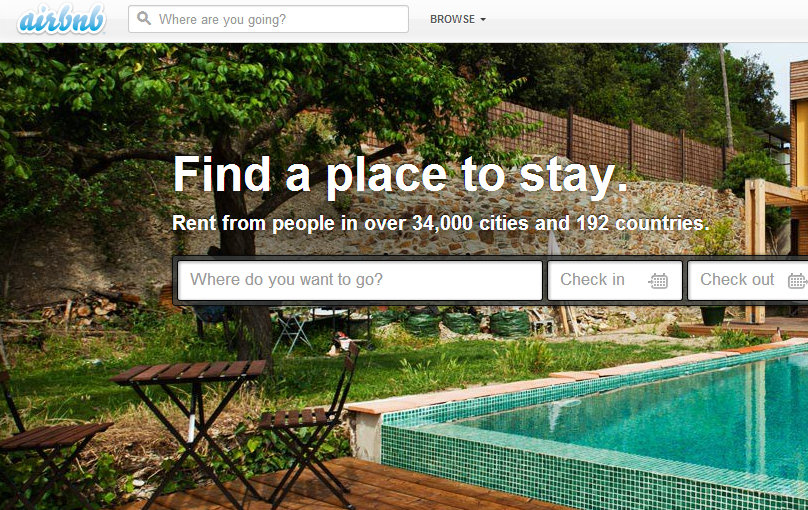Tom Friedman wrote about the sharing economy recently in his New York Times column profiling AirBnB. They are a company that helps connects travelers who don’t want to pay for an expensive hotel room and instead are matched with people willing to rent out a room in their house. This model connects a need with an available resource.
If you haven’t read it his piece, it’s a great read in Tom’s brilliant and understated style.
Ironically, I have been working on a blog post about AirBnB. One of the two founders, Joe Gebbia is someone who had approached me about another business project when I worked at another company. I can’t claim we are friends but just business acquaintances.
Joe was a design student and had an interesting product he was trying to get manufactured called CritBuns. It was a cushion designed for students doing critiques of design work – thus the crit for critique. Unfortunately, I was less than helpful getting the product made for him because at the time the company I worked for a company that had some issues with their manufacturing process and we just couldn’t deliver on what he needed. I think I did him a favor in pushing him to find someone else to make his product.
Joe went on to found, along with his partner, AirBnB.
The AirBnB model is fascinating on many levels. There are so many ways that someone could take something and rent or lease it out. An example given in the Friedman piece is that there are millions of drills in the garages tool chests in America yet they get used about 13 minutes/year.
SHARE AND SHARE ALIKE
I am interested in this shareable model because it fits into the disruptive approach to business. It screams the question – how could someone do something with an existing underutilized asset where there is a pent up demand and need? It is like a puzzle. Can you solve a problem whereby a consumer/business has a need and you have to use an existing and underutilized resource.
I love these kinds of marketing games.
Here are nine underutilized assets worth thinking about if you are considering starting a business
KITCHENS: How many restaurants and their kitchens that go unused from 1 am to 8 am most days?
CARS: How many hours per day is your car being used? Mine sits idle about 21 hours/day. In doing some research, I learned about www.lyft.com who is running with this idea.
TOOLS OF ALL KINDS: From grass mowing equipment to pruning shears to drills, think of how much stuff we all have that gets used a few hours each month. This would apply to kitchen equipment like fancy blenders and food processors too.
CLOTHING: Sharing clothing is an odd thought but I have a tuxedo I wear about once every 3 years. What is its value on an open market? How about women who have lots of fancy pocketbooks- what if they rent them out for an evening to recoup some of their cash outlay?
PRODUCE: Think of all the zucchini that gets brought to an office as freebies for colleagues. Is there a market for the produce home grown that can’t be consumed by the owner? Or better yet, how can we collect and get this food to a place that feeds the homeless.
BOOKS: I must have 500 books on my shelf that sit there all year long. I occasionally go back and reread one or two. Is there a way to squeeze some value out of those books or even a fair market exchange? How about the magazines that you get each month and sit in a basket? Could those have a secondary market? How about my DVD’s or old videos?
HOME OFFICE SPACE: Imagine you need an office and someone has an empty house all day long with a nice working office. Could you rent that space to someone who needs a place to work quietly? www.breather.com is actually working on something like this concept.
COMPUTING SPACE: Why isn’t there a way to harness computing power more efficiently across all the excess capacity that is out in the world? I know there are some projects like this that have been started by NASA, SETI and others but can’t you see how this could expand?
SCHOOLS: Most schools are empty about 30% of the time each year. From 6 pm to 6 am and on weekends they sit idle. There must be a use for these resources that could help support education.
SCHOOLS: Most schools are empty about 30% of the time each year. From 6 pm to 6 am and on weekends they sit idle. There must be a use for these resources that could help support education.
All of these opportunities require a well-thought-out business plan, require trust and an investment in lots of time. The distribution of the goods or underutilized asset is a big part of the puzzle to be solved. Check out www.shareable.net for more on the sharing economy and cities that are promoting these efforts.
But sharing is only going to be a bigger and more important part of our economy. With limitations on resources and a need to be more eco-friendly, who can’t imagine the world where things become shared resources and not just your possession.
But sharing is only going to be a bigger and more important part of our economy. With limitations on resources and a need to be more eco-friendly, who can’t imagine the world where things become shared resources and not just your possession.
Thanks for sharing.
Note: When I am not researching interesting business models like the sharing economy, I try to unravel the mysteries of marketing. Won’t you share my work with one of your marketing friends?






The amount of items and spaces that go unused in the US (and worldwide for that matter) is unreal. In the US boating industry in 2011, boats were left idle 92% of the time – which tells me that it is time to start sharing everything, even our boats!
Check out this boat-sharing website, getmyboat.com
Kira, You comment is on target with my comments in the blog. Thanks for the boat sharing website info. Cheers.